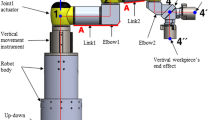Abstract
A review of the recent trends of robots would show that robots are gradually being miniaturized. However, most commercially available speed reducers suffer from the limitations in terms of structure and vibration when applied to small robots. A new speed reducer mechanism was designed to check the reducer ratio and contact points between the balls and inclined planes. Contact force analysis between the gear curves and the balls and contact force analysis between the balls and inclined planes were conducted using a numerical method and FEM analysis. This virtual prototype simulation provided essential data and analysis foundation for the physical prototype’s manufacture and testing. Meanwhile, it also provided the important basis for optimizing the tooth profile and the performance. A speed reducer was manufactured to check the performance. This manufactured thin plate-type speed reducer imposed less compressive stress on the tooth profile and the balls, which greatly increased the facility of the robot.
Similar content being viewed by others
References
W. G. Molyneux, The follower tooth reduction gear, Mechanisms 1972, I. Mech. E., London, G.B., (1973) 15–23.
Cyclo reducer catalog, Sumitomo Heavy Industry Ltd., Tokyo, Japan, F0101-2 (1999).
Harmonic drive CSF-3 series technical data, Harmonic Drive systems Inc., Tokyo, Japan, 0710-2R-TCSF3 (2008).
W.-K. Nam and S.-H. Oh, A design of speed reducer with traperzoidal profile for robot manipulator, JMST, 25(1) (2011) 171–176.
X. Li, W. He, L. Li and L. C. Schmidt, A new cycloid drive with high-load capacity and high efficiency, ASME, 126 (2004) 683–686.
KR Patent 10-0986127 (2010).
Motion of thin plate type speed reducer, http://youtu.be/6pywmYi9dgQ, (2012).
E. K. Buckingham, Revised manual of gear design: Spur and internal gears, Mano Press (1980) 75–86.
N. P. Chironis, Gear design and application, McGraw-Hill, 4–20.
R. Stawinoga, Elevator drive systems, vertical report (1999) 4–20.
D. G. Zill and M. R. Cullen, Advanced engineering mathematics, Jones and Bartlett, 459–463.
Author information
Authors and Affiliations
Corresponding author
Additional information
Recommended by Editor Sung-Lim Ko
Won-Ki Nam received the B.S. degree in 2006 and the M.S. degree in 2008, both from Chung-Ang University of Korea, Seoul, where he is currently a Ph.D. candidate in the Department of Mechanical Engineering. His research interests include robotics, harmonic driver system, cycloid speed reducer, and designing of tooth profiles.
Jae-Won Shin received the B.S. degree in 2011 from Chung-Ang University of Korea, Seoul, where he is currently a Ph.D. candidate in the Department of Mechanical Engineering. His research interests include robotics, harmonic driver system, cycloid speed reducer, and designing of tooth profiles.
Se-Hoon Oh received the Ph.D. degree from the Imperial College of U.K. He is currently a Professor with the Department of Mechanical Engineering, Chung-Ang University, Seoul, Korea. His research interests include robotics, harmonic driver system, cycloid speed reducer, and bicycle.
Rights and permissions
About this article
Cite this article
Nam, W.K., Shin, J.W. & Oh, S.H. Design of thin plate-type speed reducers using balls for robots. J Mech Sci Technol 27, 519–524 (2013). https://doi.org/10.1007/s12206-012-1242-5
Received:
Revised:
Accepted:
Published:
Issue Date:
DOI: https://doi.org/10.1007/s12206-012-1242-5




